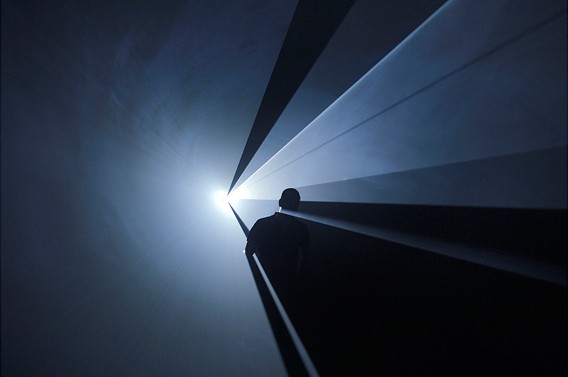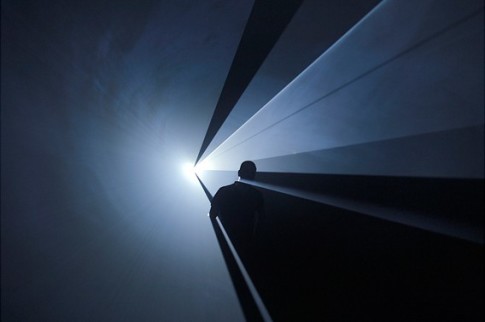
Anthony McCall, You and I Horizontal, 2006 © Anthony McCall. Photo: Blaise Adilon. Courtesy Sean Kelly Gallery, New York
About Anthony McCall
As soon as our eyes adjust to the dark, we experience something new: Solid Light – a material light, a sort of radiant, intricately folded membranes or walls that induce us to move cautiously and hesitantly.
The membrane-like walls of light emanate from one single projection point at the far end of the room; that is where our gaze first wants to go when we set out to navigate through the layers of light. But once we are enclosed in a three-dimensional radiating form and turn our gaze away from that fixed point, we soon discover that nothing is still. Everything is in motion. Not just me and the other visitors, moving like astral bodies through the stratums of light– but also the materialised light itself: on the wall we can see the white lines of a drawing slowly move, and in the process dragging along entire walls of light. Slowly, slowly, yet fast enough for us to perceive the movement.
What is it we are seeing? What categories and concepts can we apply to handle this experience? An experience we have probably never had before… On a fundamental level, it is familiar from the way the beam of the film projector cuts through the darkness of the cinema. Or the second-hand experience of that, anyway, as it appears in photos or films from the past, when the cigarette smoke lay heavy in the movie theatres … But it is also, despite its vague immateriality, closely related to the highly physical and filmic experience of moving through one of Richard Serra’s large sculptural works from the past 15 years – for instance, his Torqued Ellipses. But what we are seeing is also a drawing – and isn’t there a strong sense of performance, with you, me and the other viewers as participants?
Ever since his early works dating from around 1970, Anthony McCall has created works that have been intensely sensual – made to experience – while imbued with an unmistakable philosophical dimension. Expressed in the rather hackneyed categories of isms, one could say that he has always operated in the field between minimalism and conceptual art.
Anthony McCall’s artistic career is, in many ways, fairly typical of artists in his generation – with one important exception. Born and educated in London, he graduated from art school, where he had focused on photography, in the midst of the student rebellions in 1968. He gradually moved from photography to performance and to what is sometimes called Structural Cinema, represented by film-makers such as Michael Snow and Hollis Frampton – the context in which McCall’s Solid Light works were made. He also gradually moved from London to New York, emigrating in 1973.
The first of his now legendary Solid Light films, Line Describing a Cone was actually first shown at Fylkingen in Stockholm on 30 August, 1973. During half an hour, a narrow ray of light was projected through the room by a 16 mm projector, slowly but steadily transforming into an arch, before finally cutting out a large cone of light in the dark room. This is basically the same experience we encounter today in McCall’s installations, although these old works were 16 mm animations. A few days after the Fylkingen show, McCall did a performance with fires, Fire Cycles II in a park in the centre of Stockholm (also organised by Fylkingens), and the following year, Malmö konsthall featured a group exhibition where all four films by McCall on the cone theme where shown, while Jean Sellem at Galleri St Petri in Lund showed Long Film for Ambient Light, a “film” without either film, camera, projectors or screen. The film was simply natural light that was filtered into the space. Light in space.
The fact is, that twenty-five years passed before the art world caught up with McCall’s works from the 1970s and started showing them in exhibitions at Centre Pompidou, the Whitney Museum and Tate Modern. And at the Whitney Biennial in 2004, Anthony McCall then took the audience by surprise with an entirely new work: Doubling Back. This work reverts to Line Describing a Cone dating thirty years back, but new technology enabled higher visuality and, above all, greater complexity, both in animation and projection and – now that the smoky and dusty lofts are definitely a thing of the past – the “fog” in the room required for the light to materialise. Doubling Back, which was recently acquired for the Moderna Museet collection, opens the second chapter in an oeuvre that has come to assume an absolutely central position in art at the end of the first decade of the 21st century.
Lars Nittve
About Anthony McCall
Anthony McCall is now based in New York. In the early 1970s, McCall was part of the British avant-garde, and his work included film and performance. In 1973, he started making the film series Solid Light, but later withdrew from the art world. McCall resumed his artistic career in the 2000s and has participated in numerous international solo and group exhibitions, including the Whitney Biennial (2004), The Expanded Eye, Kunsthaus Zürich (2006) and Projections: Beyond Cinematic Space, Hamburger Bahnhof, Berlin (2006).
Selected solo exhibitions
Tate Britain, London, 2004, Sean Kelly Gallery, New York, 2007/2009, Serpentine Gallery, London, 2007, Utzon Center, Aalborg, 2008, Hangar Bicocca, Milan, 2009.
Selected group exhibitions
Whitney Museum of American Art, New York, 2001, Hayward Gallery, London, 2004, Museum für Moderne Kunst, Frankfurt, 2005, Museum of Modern Art, New York, 2008.

